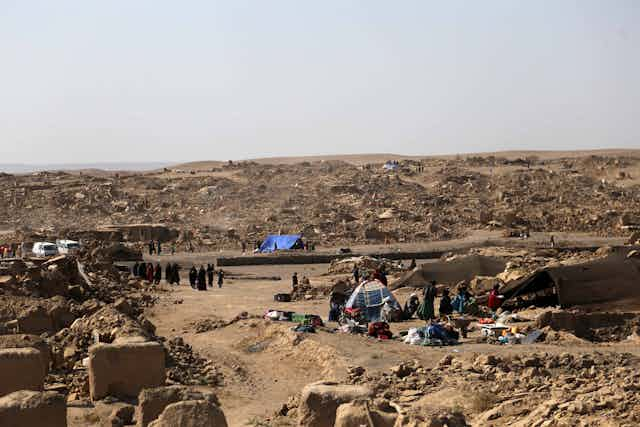Over 1,000 people are thought to have been killed in the latest earthquake to hit Afghanistan. Humanitarian aid agencies are scrambling to help the affected villages. But the realities of Taliban rule are starting to have an impact on the ground, as relations between the authorities and NGOs fray.
Two earthquakes struck Afghanistan’s western province of Herat on October 7 and a third on October 11. Zindajan district, 50km west of Herat, was the worst affected area. It is a rural area of scattered hamlets, where most people live in traditional single-storey mud-brick structures. In villages near the epicentre, the damage was total. Mud structures simply collapsed on their occupants. As the October 7 quakes occurred late in the morning, the victims were mainly women and children, who were indoors. Men working in the fields were spared.
Over 1,000 people died under the falling masonry. More than twice this number were injured or were trapped and had to be dug out and the UN estimates that 12,000 people have been affected. There is a regional tradition of mud domed construction (gombad) which, when well-constructed, is considered to be earthquake resistant. However, many contemporary village houses employ heavy wooden, or indeed concrete, beams to support the roof, especially if they have added an upper storey. Many casualties were probably caught under these beams.
Responders were struck by the intensity of the destruction and the sight of Zindajan villages with barely a single home left standing. About twice as many have been killed as died in the earthquake in Paktika province last year.
The rescue
Afghanistan’s legacy of decades of conflict and natural disasters means that humanitarian aid agencies, the private sector and even the Taliban authorities are grimly familiar with disaster response. Deputy Prime Minister Mullah Baradar visited the affected area on October 8 and promised to help rebuild houses and pledged cash assistance. The Taliban inherited a functional government infrastructure and so their officials from the Disasters Department showed up to survey the area and coordinate.
Businesses active in Herat, including the Azizi Bank, pledged cash and material assistance to the survivors. Humanitarian organisations already active in Afghanistan, including UN agencies, the EU’s humanitarian wing ECHO, the Red Cross and Red Crescent societies and NGOs deployed personnel and provided essential medical supplies to hospitals overstretched by the influx of injured.

They have delivered tents and non-food items for those who have lost their houses. And they have distributed food and cash, to help people survive until they can go back to work and restart their lives.
The hunger emergency
While the Herat earthquakes have brought suffering to those directly affected, the survivors join the much larger numbers of Afghans already struggling to survive in a broader humanitarian crisis. The UN has estimated that over 15 million are affected by the hunger emergency caused by drought and an economic collapse.
Meanwhile, Pakistan has threatened to expel 1.7 million undocumented Afghan migrants and Iran regularly deports thousands of Afghans which it says have entered the country illegally or overstayed.
Grim as the situation may be today in the Herat hospitals and flattened villages, the aid agencies on the ground have the capacity to respond to Heratis’ immediate needs and appeal for resources to prepare for winter. But responding to the collapse of livelihoods, hunger and mass migration is even more daunting, given the scale of the problem and difficulties inherent in working in Taliban-run Afghanistan.
On the positive side, the earthquake response illustrates that, when both sides are on board, the Taliban and humanitarian agencies can operate alongside each other to deliver for the population. The fact that Taliban leaders are subject to UN sanctions does not prevent pragmatic engagement and coordination on the ground. International agencies meet with Taliban officials of relevant departments such as Public Health. But they avoid handing over aid money to them, instead relying on their own operations and NGOs to deliver resources.
Strained relations
The fact is relations between the Taliban authorities and humanitarian organisations have become strained. The Taliban increasingly demand a say in how aid is delivered and to whom. Agencies have experienced a shrinking of “humanitarian space” (the freedom to operate independently according to agreed principles) leading donors to question whether their resources will reach the most vulnerable Afghans. Donor commitments to humanitarian operations in Afghanistan are sharply down on last year.
Donor fatigue has probably been exacerbated by both Taliban interference and their persistent opposition to universal norms by restricting girls’ education and women’s employment.
Taliban policies and governance style also directly contribute to the problem by hurting the economy. The World Bank’s latest assessment warns of “economic uncertainty”.
Initial Taliban performance, in funding a national budget, without external support, was impressive. But now the Taliban’s aggressive tax collection is depressing demand. And in a replay of the “guns v butter” problem, the Taliban are channelling resources to their security forces leaving little for the civilian population.
Meanwhile, the World Bank estimates that more than half the population is in extreme poverty. Continued drought and another poor harvest are compounding the problem of hunger. Climate change vulnerability makes the longer-term outlook even more bleak.
All this drives thousands of Afghans to migrate, dodging border controls and taking their chances in the Iranian labour market or trying to head further west. An inflexible Afghan administration which is isolated at home and internationally is ill-prepared to cope with these burgeoning humanitarian challenges.

